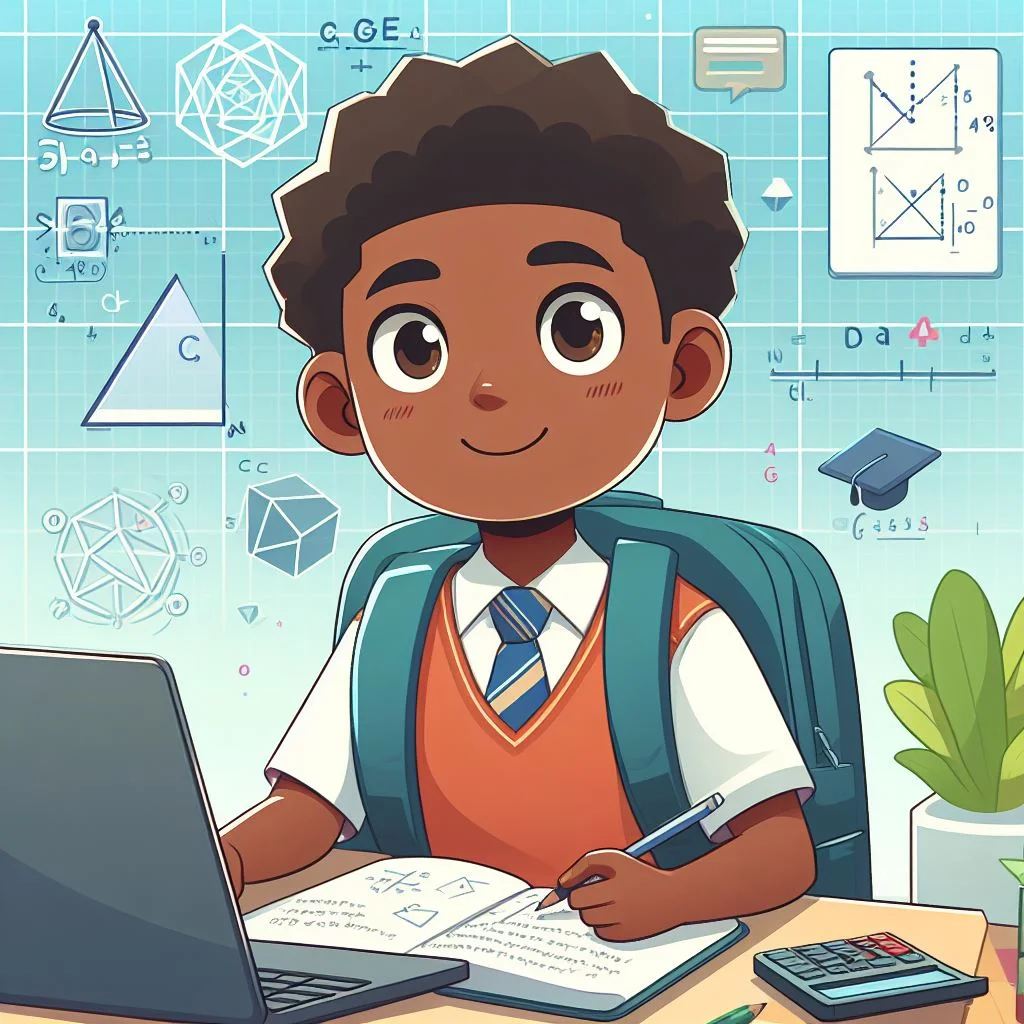Geometry Projects: Creative Ways to Learn and Apply Geometry Concepts

Geometry, a branch of mathematics intricately woven into the fabric of shapes, sizes, and the properties of space, frequently emerges as a formidable challenge for students navigating the realm of mathematical understanding. The intricate dance of lines, angles, and figures often leaves learners grappling with abstract concepts. However, the key to unraveling the mysteries of geometry lies in embracing a creative approach to learning. By seamlessly integrating imaginative geometry projects into your educational odyssey, the once-daunting subject transforms into a captivating exploration of spatial relationships and mathematical intricacies. This blog endeavors to be your guide through the realm of hands-on geometry projects, offering a trove of interactive experiences that not only infuse joy into the learning process but also serve as catalysts for a profound comprehension of geometric principles. As we embark on this journey, the aim is not merely to decode the intricacies of geometric shapes but to empower you with a set of skills that transcends the classroom, particularly in the realm of problem-solving. Through a curated selection of projects, we will delve into the realms of paper folding art, geometric puzzles, the natural symmetries of our surroundings, architectural design, 3D printing marvels, the fusion of mathematics and art, coding adventures, and the practical applications of geometry in mathematical modeling. Each project serves as a stepping stone, guiding you towards a deeper understanding of geometry while simultaneously honing your analytical prowess. The ultimate goal is to furnish you with the confidence and insights required to complete your geometry assignment with a newfound sense of assurance.

As we navigate through these diverse projects, envision the transformative power they hold – turning the once abstract concepts into tangible, relatable experiences. Picture yourself folding paper to grasp the nuances of geometric transformations, solving puzzles that demand critical thinking, capturing the elegance of nature through a photographic lens, and architecting miniature worlds that obey the laws of geometry. Imagine the hum of a 3D printer bringing your geometric creations to life, the strokes of a mathematical artist crafting beauty through precision, the lines of code translating abstract theories into digital realities, and the application of geometry to solve real-world challenges through mathematical modeling. Each project not only enhances your understanding of geometry but also equips you with the skills to approach assignments with a creative and analytical mindset. Through this exploration, the often-dreaded subject of geometry becomes a tapestry of discovery and innovation, where learning is not confined to textbooks but extends into the realms of imagination and hands-on experience. So, let us embark on this geometric adventure together, where shapes and sizes become the building blocks of your mathematical prowess, and the challenges of assignments transform into opportunities for confident problem-solving.
Paper Folding Art: Exploring Transformations
Embarking on the captivating journey of Paper Folding Art: Exploring Transformations introduces learners to the enchanting world of geometric metamorphosis. This hands-on project seamlessly integrates the principles of reflection, rotation, and translation into the folds of paper, providing a tangible and visual understanding of fundamental geometric transformations. Origami, the ancient Japanese art of paper folding, serves as a playful yet powerful medium through which students can grasp complex geometric concepts with ease. As one meticulously manipulates paper to create symmetrical and asymmetrical figures, the inherent mathematical beauty of transformations comes to life. Beyond its aesthetic appeal, this project cultivates spatial awareness and hones problem-solving skills, laying a solid foundation for more advanced geometric studies. The tangible nature of paper folding makes abstract concepts concrete, fostering a deeper comprehension of geometry. Through this artful exploration, students not only enhance their understanding of transformations but also set the stage for a more creative and confident approach to geometry assignments, transforming the study of shapes into an engaging and transformative experience.
Geometric Puzzles: A Tangible Approach to Problem Solving
Embark on a captivating journey of problem-solving with geometric puzzles, a hands-on and tangible approach that transcends traditional learning methods. These puzzles, exemplified by classics like tangrams, offer a unique avenue to hone your spatial awareness and critical thinking skills. As you manipulate geometric pieces to form intricate patterns and shapes, you're not merely solving a puzzle – you're actively engaging with mathematical concepts. Tangible in nature, these puzzles encourage a deeper understanding of geometric relationships, fostering an intuitive grasp of angles, symmetry, and spatial configurations. This approach extends beyond the confines of textbooks, providing a dynamic and interactive way to internalize abstract geometric principles. Geometric puzzles serve as more than just recreational activities; they become a bridge between theory and application, laying the groundwork for effective problem-solving in geometry assignments. With each piece placed and every challenge conquered, you're not only solving puzzles but unlocking the door to a richer comprehension of geometry, one that is both enjoyable and intellectually rewarding.
Geometry in Nature: A Photographic Exploration
Embarking on a journey to uncover the intrinsic geometry woven into the fabric of the natural world, a photographic exploration of geometry in nature offers a captivating lens through which to view mathematical concepts. Armed with a camera, one ventures into the outdoors, capturing the symmetrical marvels of leaves, the intricate angles of branches, and the mesmerizing spirals within seashells. This hands-on engagement transcends the confines of a classroom, demonstrating that geometry is not an abstract concept confined to textbooks but a tangible, omnipresent force. Analyzing these organic formations, from the hexagonal patterns in beehives to the Fibonacci spirals in sunflowers, not only reinforces geometric principles but also fosters a profound appreciation for the elegance of nature's design. The photographic journey becomes a conduit for understanding symmetry, proportion, and spatial relationships, seamlessly intertwining the beauty of the natural world with the precision of mathematical concepts, making geometry a dynamic and relevant discipline that extends far beyond the confines of traditional learning environments.
Architectural Design: From Concepts to Blueprints
Embarking on the journey of architectural design opens a gateway to a dynamic fusion of creativity and precision. From conceptualization to the meticulous drafting of blueprints, this geometry project immerses students in the practical application of mathematical principles. As aspiring architects, participants delve into the intricacies of spatial relationships, exploring the mathematical foundations that underpin structures. Creating scale models of buildings not only sharpens geometric understanding but also fosters an appreciation for the balance between form and function. This hands-on experience equips students with a practical toolkit for addressing complex geometry assignments involving area calculations, volume estimations, and proportional relationships within architectural designs. By navigating the transition from abstract geometric concepts to tangible blueprints, learners develop a profound understanding of how mathematical precision translates into real-world construction. Through this project, students not only gain valuable insights into geometry but also cultivate essential skills for problem-solving, critical thinking, and the intersection of mathematics with the architectural marvels that shape our surroundings.
3D Printing: Transforming Virtual Concepts into Reality
3D Printing: Transforming Virtual Concepts into Reality" opens a gateway to a revolutionary approach in understanding and applying geometric principles. In this cutting-edge project, students delve into the world of three-dimensional design, where virtual models materialize into tangible objects. By learning to manipulate CAD software and exploring the intricacies of geometric shapes, students gain a profound insight into spatial relationships and the principles governing 3D structures. The tactile experience of witnessing their digital creations come to life through 3D printing not only reinforces geometric concepts but also instills a sense of accomplishment. This hands-on approach bridges the gap between theoretical knowledge and practical application, preparing students to tackle assignments involving complex 3D shapes and spatial problem-solving. The project not only nurtures technical skills but also fosters creativity as students conceptualize, design, and bring their ideas into the physical realm, marking a transformative journey where virtual concepts evolve into palpable reality through the marvels of 3D printing technology.
Mathematical Art: Creating Beauty through Geometry
Mathematical Art: Creating Beauty through Geometry" is a captivating fusion of precision and aesthetics, where mathematical principles intertwine with artistic expression to produce visually stunning masterpieces. This interdisciplinary approach transforms abstract geometric concepts into tangible, breathtaking creations. Inspired by visionaries like M.C. Escher, mathematical art projects invite learners to explore the inherent beauty in numerical precision. Through meticulous design, patterns, and symmetries, students not only enhance their understanding of geometric principles but also cultivate an appreciation for the aesthetic possibilities within mathematical structures. This creative endeavor allows for the synthesis of left-brain logic and right-brain creativity, demonstrating that mathematics is not merely a theoretical pursuit but an art form that transcends traditional boundaries. Whether through intricate tessellations, mesmerizing fractals, or visually striking geometric sculptures, mathematical art provides a unique avenue for individuals to engage with and convey complex mathematical ideas while simultaneously creating works of beauty that inspire a profound appreciation for the inherent elegance of geometry.
Coding and Geometry: A Digital Fusion
Coding and Geometry: A Digital Fusion" opens a gateway to a symbiotic relationship between abstract mathematical concepts and real-world applications. In this dynamic fusion, students embark on a journey where lines of code seamlessly translate into geometric constructions, transformations, and visualizations. Programming platforms like Scratch or Python become the canvas for exploring the intricate interplay of shapes, angles, and spatial relationships. Through coding, learners not only demystify geometric abstractions but also witness the tangible outcomes of their digital endeavors. This hands-on approach not only enhances problem-solving skills but also instills a deeper understanding of the underlying mathematical principles. As algorithms come to life through code, students gain a practical perspective on geometry, bridging the gap between theoretical knowledge and practical application. The digital fusion of coding and geometry not only enriches the learning experience but equips students with essential skills for navigating the increasingly technology-driven landscape, fostering a harmonious integration of mathematical precision and computational creativity.
Mathematical Modeling: Solving Real-World Problems
Mathematical modeling serves as a powerful tool for addressing real-world challenges by applying mathematical concepts to practical situations. In this dynamic approach to problem-solving, mathematical models act as bridges between theoretical understanding and tangible solutions. By selecting and defining relevant variables, formulating equations, and utilizing geometric principles, students can tackle a wide range of complex issues. Whether optimizing traffic flow in a city, designing eco-friendly packaging, or predicting the spread of a disease, mathematical modeling empowers individuals to explore, analyze, and propose innovative solutions. This process not only reinforces mathematical concepts learned in the classroom but also instills a sense of applicability and relevance to the field. Engaging in mathematical modeling projects not only hones one's problem-solving skills but also cultivates a deep appreciation for the role mathematics plays in addressing the multifaceted challenges of the real world, preparing students to approach assignments with a practical and insightful mindset.
Conclusion
In conclusion, the integration of creative geometry projects into the learning process emerges as a transformative approach, turning the often daunting subject of geometry into an engaging and dynamic exploration. From the tactile experience of paper folding art to the cognitive challenges posed by geometric puzzles, the diverse range of projects discussed here serves as a gateway to a deeper understanding of spatial concepts. Venturing into nature and architectural design connects geometry to the real world, while 3D printing and coding propel the subject into the digital age, fostering a holistic comprehension. Through mathematical art and modeling, students not only solidify their grasp on geometric principles but also witness the profound impact of mathematics on aesthetic expression and real-world problem-solving. These projects not only make geometry more accessible and enjoyable but also equip students with invaluable skills, enhancing their ability to approach assignments with confidence, creativity, and a practical understanding of how geometry permeates various facets of our lives. Embracing these creative endeavors, students can unlock the beauty and relevance of geometry, paving the way for a more profound and enduring connection with this fundamental branch of mathematics.